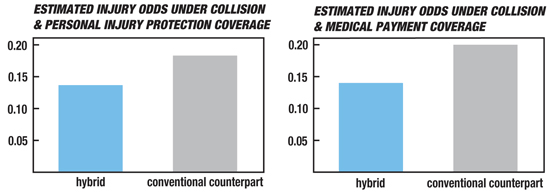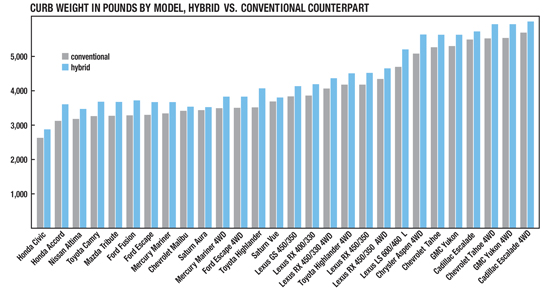HYBRID ADVANTAGE
![]()
Hybrids have a safety edge over their conventional twins when it comes to shielding their occupants from injuries in crashes, new research by the Highway Loss Data Institute (HLDI), an Institute affiliate, shows. On average, the odds of being injured in a crash are 25 percent lower for people in hybrids than people traveling in nonhybrid models. “Weight is a big factor,” says Matt Moore, HLDI vice president and an author of the report. “Hybrids on average are 10 percent heavier than their standard counterparts. This extra mass gives them an advantage in crashes that their conventional twins don’t have.” He notes that other factors, such as how, when, and by whom hybrids are driven, also may contribute. Researchers included controls to reduce the impact these differences may have had on the results.
The new finding is more good news for greenminded drivers who don’t want to trade safety for fuel economy. Not so long ago, car buyers had to choose between the two because fuel-efficient cars tended to be smaller and lighter. Now, consumers have more options than ever when it comes to picking an environmentally friendly — and crashworthy— vehicle.
“Saving at the pump no longer means you have to skimp on crash protection,” Moore says.
In the study, HLDI estimated the odds that a crash would result in injuries if people were riding in a hybrid versus the conventional version of the same vehicle. The analysis included more than 25 hybrid-conventional vehicle pairs, all 2003- 11 models, with at least 1 collision claim and at least 1 related injury claim filed under personal injury protection or medical payment coverage in 2002-10.
Collision coverage pays to repair or replace an at-fault driver’s vehicle after a crash with an object or another vehicle. Personal injury protection, or PIP, pays medical expenses for injuries insured drivers and other people in their vehicles sustain in a crash, no matter who is at fault in the collision. Medical payment, or MedPay, covers treatment costs when insured drivers or their passengers are hurt in crashes when the driver is at fault. PIP coverage is sold in states with no-fault insurance systems, and MedPay coverage is sold in tort states.
Hybrids’ injury odds were 27 percent lower than their standard counterparts for collision claims with a related PIP claim and 25 percent lower than their twins for collision claims with a related MedPay claim.
Crash physics: It’s well known that size and weight influence injury likelihood. In a crash involving two vehicles that differ in size and weight, the people in the smaller, lighter vehicle will be at a disadvantage. The bigger and heavier vehicle will push the smaller, lighter one backward on impact. This means less force on people in the heavier vehicle and more on the people in the lighter one. Greater force means greater risk, so people in the smaller, lighter vehicle are more likely to be injured. Even in single vehicle crashes, heavier vehicles have an advantage because they are more likely to move, bend, or deform objects they hit (see Status Report, April 14, 2009; on the web at iihs.org).
Even with advances in occupant protection, larger vehicles still are safer choices than smaller ones. That’s why downsizing vehicles to improve fuel efficiency has traditionally resulted in safety trade offs. The trend among automakers nowadays is to boost fuel economy by designing more efficient internal combustion engines and by adding hybrids to their fleets.
Although hybrids share the same footprint and structure as their conventional counterparts, they outweigh them because of the added heft of battery packs and other components used in dual-power systems. At about 3,600 pounds, a hybrid Honda Accord midsize sedan, for example, can weigh as much as 480 pounds more than a conventional Accord. A hybrid Toyota Highlander, a midsize SUV, weighs about 4,500 pounds, compared with about 4,170 pounds for the conventional Highlander.
“Park any of these pairs side by side and you can’t tell the hybrid from the traditional vehicle just by looking at them,” Moore points out. “But you could if you were to put them on a scale.”

Disentangling size and mass: Moore says the study is unique in its ability to examine how vehicle mass affects injury rates. One question safety advocates long have grappled with is, how much does size affect crashworthiness as compared with weight? These two factors have separate effects, but they are highly correlated. Disentangling them requires keeping one variable constant while modifying the other.
“What we ended up with was a study that may be as good a natural experiment as can be done to examine the effects of mass independent of size,” Moore says.
Researchers excluded the Toyota Prius and Honda Insight from the study because they are only sold as hybrids. The analysis controlled for calendar year, rated driver age and gender, marital status, vehicle density (number of registered vehicles per square mile), garaging state, vehicle series, and vehicle age.
Hybrids’ driver death rates: HLDI’s findings complement other Institute research into how vehicle size and weight affect crash injuries. A recent study found that driver death rates for 2005-08 models with at least 100,000 registered vehicle years decreased as vehicle weight increased (see Status Report, June 9, 2011).
Every hybrid in the analysis had a lower driver death rate than its conventional twin. For example, the Honda Civic Hybrid had an overall driver death rate of 53 per million registered vehicle years, compared with 55 for the nonhybrid Civic. The hybrid Toyota Camry had a driver death rate of 36, while the standard Camry’s rate was 10 points higher.

HYBRIDS CHALK UP MORE INJURY CLAIMS FOR PEDESTRIANS
Hybrids may protect occupants in crashes better than their nonhybrid counterparts, but they also may be as much as 20 percent more likely to be involved in pedestrian crashes with injuries than their conventional twins, a new Highway Loss Data Institute (HLDI) analysis indicates.
Analysts examined how frequently bodily injury liability claims were filed for 17 hybrids and their nonhybrid counterparts when there was no related collision or property damage. Studied vehicles included 2002- 10 full hybrid models and their standard twins during 2004-10 calendar years, totaling 25,382 bodily injury liability claims and 2.9 million years of exposure.
Bodily injury liability coverage insures against medical and other expenses for injuries that at-fault drivers inflict on occupants of other vehicles or others on the road.
Claim frequencies were defined as claims per 1,000 insured vehicle years (an insured vehicle year is 1 vehicle insured for 1 year or 2 for 6 months each, etc.). The analysis controlled for calendar year, rated driver age, rated driver gender, marital status, risk, registered vehicle density, garaging state, vehicle series, and vehicle age.
HLDI’s finding is in line with 2009 and 2011 studies by the National Highway Traffic Safety Administration concluding that hybrids have a higher rate of pedestrian and bicyclist crashes than nonhybrids (see Status Report, Dec. 22, 2009; on the web at iihs.org).
“When hybrids operate in electric only mode pedestrians can’t hear them approaching,” says Matt Moore, HLDI vice president, “so they might step out into the roadway without checking first to see what’s coming.”
It’s a problem that’s cropped up as hybrids have become more common, and it’s one the National Highway Traffic Safety Administration is working to address. Earlier this year Congress gave the agency three years to come up with a requirement for equipping hybrids and electric models with sounds to alert unsuspecting pedestrians (see Status Report, March 30, 2011).
Moore points out that HLDI can’t definitively tell from the data that a crash involved a pedestrian. Likewise, some pedestrian crashes may have been unintentionally excluded. For example, a crash in which a person was struck and injured and the vehicle also was damaged would have been omitted because a collision claim would have been filed for the vehicle. However, a sample of the claims suggests that these are mostly pedestrian injuries.